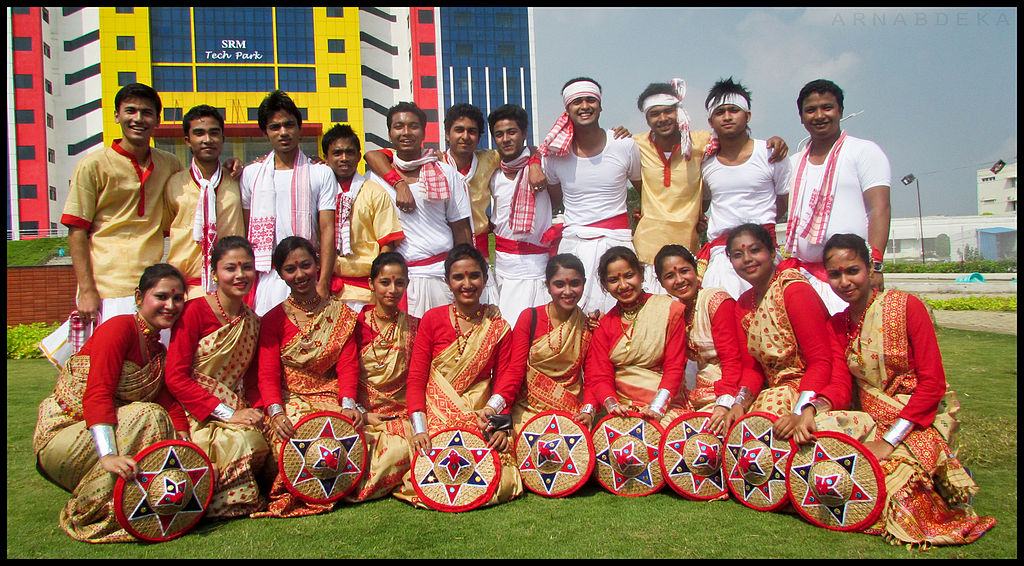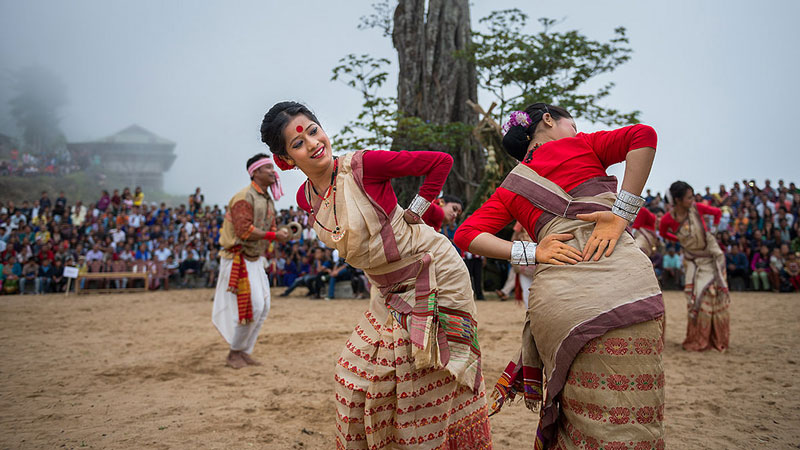ॐ श्री गणाधिपतये नमः
Source of all Images in this Blog-post : Google Images : ‘Google Image Search’ will reveal the multiple sources of every single image shared here. For more details, kindly see ‘Disclaimer‘
The state of Assam in North Eastern India celebrates a series of three significant non-religious festivals collectively known as Bihu. These festivals include Rongali or Bohag Bihu, which takes place in April, Kongali or Kati Bihu, which is observed in October, and Bhogali or Magh Bihu, celebrated in January.
The Rongali Bihu is the most important of the three, celebrating the colourful spring festival. The Bhogali Bihu or the Magh Bihu is a harvest festival, with community feasts. The Kongali Bihu or the Kati Bihu is the sombre, thrifty one reflecting a season of short supplies and is an animistic festival.

The Rongali Bihu coincides with the Assamese New year as well as with the new year of other regions of East and South-East Asia which follow the Buddhist calendar. The other two Bihu festivals every year are unique to the people of Assam.
Similar to many other Indian festivals, the Bihu celebration is closely linked to agriculture, with a particular focus on rice. Bohag Bihu, also known as Rongali Bihu, is a time for sowing seeds and marks the beginning of the Assamese New Year.
Kati Bihu, on the other hand, is a form of the festival that is associated with crop protection and the worship of plants and crops, representing an animistic aspect of the Bihu celebration. Finally, Bhogali Bihu is a harvest festival, with the granaries full of rice and an abundance of feasting and eating during this period.
Assamese celebrate the Rongali Bihu with feasts, music and dancing. Some hang brass, copper or silver pots on poles in front of their house. Bihu is also celebrated overseas by the Assamese diaspora community living worldwide.
The term Bihu is also used to imply Bihu dance otherwise called Bihu Naas, and Bihu folk songs also called Bihu Geet.
The Three Bihu festivals of Assam in detail
Rongali Bihu or Bohag Bihu
Bohag Bihu, also known as Rongali Bihu, is celebrated in mid-April and is the most popular Bihu in Assam. It marks the onset of the Assamese New Year and the arrival of the spring season. This festival is also observed in other regions of India such as Bengal, Manipur, Mithila, Nepal, Orissa, Punjab, Kerala, and Tamilnadu, but it has different names in each region.
Bohag Bihu is celebrated for seven days and is a time of feasting and merriment. The farmers prepare their fields for the cultivation of paddy, and there is a sense of joy all around Assam. The women of Assam prepare traditional food such as Pitha, Larus, and various drinks made by local tribes, such as Chuje by Deoris, Nam-Lao by Tai-Ahom, Aapong by Mising tribe, and Jolpan, which captures the essence of the season.
The celebration of Bohag Bihu includes the Goru Bihu or Cow Bihu, where cows are washed and worshipped. The next day is Manuh Bihu or Human Bihu, which is the New Year’s Day. This is a day of getting cleaned up, wearing new clothes, and celebrating the new year with fresh vigor. The third day is Gosai Bihu or Gods Bihu, where the statues of gods worshipped in all households are cleaned and worshipped, asking for a smooth new year.
The Bihu dance is an essential part of the celebration, and the folk songs associated with Bohag Bihu are called Bihugeets or Bihu songs. The form of celebration and rites vary among different demographic groups.
Kongali Bihu
Kongali Bihu, also known as Kati Bihu, is a festival celebrated in mid-October in Assam, India. Unlike other Bihu festivals, this one has a more subdued atmosphere with less merriment and more solemnity.
During this time of the year, the paddy in the fields is in the growing stage, and the granaries of farmers are almost empty. Earthen lamps are lit at the foot of the household Tulsi plant, the granary, the garden, and the paddy fields.
In ancient times, earthen lamps were lit around the paddy fields to attract insects, acting as natural insecticides. To protect the maturing paddy, cultivators whirl a piece of bamboo and recite Rowa-Khowa chants and spells to ward off pests and evil eyes.
In the evening, cattle are fed with specially made rice items called Pitha. This Bihu is also associated with the lighting of Akaxi Gonga – lamps at the tip of a tall bamboo pole – to show the souls of the dead the way to heaven.
Kati Bihu is usually celebrated on the 19th of October, and it is an important festival for the farmers in Assam, who pray for a bountiful harvest season.







Bhogali Bihu
Bhogali Bihu, also known as Magh Bihu, is a harvest festival celebrated in mid-January in Assam, India. The word “Bhog” means eating and enjoyment, which aptly describes the festive spirit of this occasion. As the harvesting season comes to an end, granaries are full, and there is much feasting and merriment.
On the eve of Uruka, the last day of the month of Pausa, young men go to the fields, preferably near a river, to build temporary cottages called Bhelaghars with hay from the harvest fields. They light bonfires, which are the highlight of the night’s festivities. Community feasting and the exchange of sweets and greetings are also an essential part of the celebration.
Throughout the night, people sing Bihu songs, beat drums, and play games around a Meji, a structure made of bamboo and thatch. Boys roam about in the dark, playing pranks like stealing firewood and vegetables for fun.
The next morning, people take a bath and burn the main Meji. They throw Pithas (rice cakes) and betel nuts into the fire, offering prayers to the god of fire and marking the end of the harvesting year. They also carry half-burnt pieces of firewood home to throw among fruit trees for favorable results. All the trees in the compound are tied to bamboo strips or paddy stems.
The day is filled with different types of sports like Buffalo-fight, Egg-fight, Cock-fight, Nightingale-fight, and more. Besides Bhogali Bihu, various ethnic-cultural groups observe other conventional festivals such as Me-dam-me-phi, Ali-aye-ligang, Porag, Garja, Hapsa Hatarnai, and Kherai.
